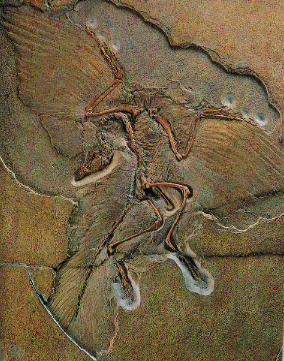Oct 09 2009
Archaeopteryx Bones Dinosaur-Like
 I wrote a couple of weeks ago about a new bird-dinosaur link and the new oldest bird, Anchiornis huxleyi, which took the title away from one of the iconic fossils of evolution – Archaeopteryx. A new study just published gives us some new information about Archaeopteryx. It turns out the structure of its bones was more like a dinosaur’s than a bird’s.
I wrote a couple of weeks ago about a new bird-dinosaur link and the new oldest bird, Anchiornis huxleyi, which took the title away from one of the iconic fossils of evolution – Archaeopteryx. A new study just published gives us some new information about Archaeopteryx. It turns out the structure of its bones was more like a dinosaur’s than a bird’s.
This has led to some annoying headlines: ‘First Bird’ Not Very Bird-Like. The new study actually does not change our thinking about Archaeopteryx – it is a basal bird, so it has some primitive bird features, and some dinosaur features. Now we know its bones were more like a dinosaur – just like its teeth and tail. This is what we would expect from a transitional species like Archaeopteryx.
For background, Archaeopteryx lithographica was first discovered in 1861 – what is now called the London specimen. There are currently a total of 10 specimens plus one separate feather (many sources I found still give the outdated number of 8 specimens, but there have been a couple more recent finds). Pictured above is the Berlin specimen.
Archaeopteryx is perhaps one of the most famous fossil species because of its timing – right around the time of the publication of Darwin’s On the Origin of Species. Darwin’s Bulldog, T.H. Huxley, was among the first to speculate that perhaps birds evolved from dinosaurs. So the discovery of Archaeopteryx was timely confirmation of both evolution and the dino-to-bird hypothesis.
It is one of the most spectacular transitional species we have. It has primitive avian features: feathers, an opposable hallux, and a fercula (wishbone). It also seems that Archaeopteryx was able to fly. But simultaneously it has many reptilian features: it lacks a bill or beak, free rather than fused truncal vertebrae, elongated cerebral hemispheres, a long bony tail, teeth, rear-attaching skull (birds’ attach from below), abdominal ribs, and claws on three unfused digits.
It also lacked some modern adaptations to flight, such as a triosseal canal, a specialized structure that enables modern birds to perform a wing flip maneuver that helps them take off from a standing start on the ground.
Generally speaking, Archaeopteryx retains many more features of theropod dinosaurs than it has modern avian features, and it lacks sophisticated adaptations of flight. It was more a flying feathered dinosaur than a bird. Again – a compelling transitional species.
This new study, therefore, fits right in with our current view of Archaeopteryx (which doesn’t make for splashy headlines). Looking at the bones of Archaeopteryx:
The bones from these early birds looked similar to those of same-sized dinosaurs, as they were dense with small blood vessels and bone cells that were flattened and parallel.
This implies that Archaeopteryx was slow growing, like dinosaurs, rather than fast growing like birds, which we would then infer was a later adaptation in the line that led to modern birds.
The stunning evidence for the evolution of birds from dinosaurs does not stop evolution deniers, who are immune to evidence. Answers in Genesis has an article on Archaeopteryx, and they get just about everything wrong. They grossly misrepresent the factual evidence (claiming, for example, that there is little evidence for feathered dinosaurs) and resort to their go-to logical fallacies (Archaeopteryx is just another kind of creature that God made). I will leave it to my interested readers to take it apart further – it’s a good primer on the logical fallacies of denial.






